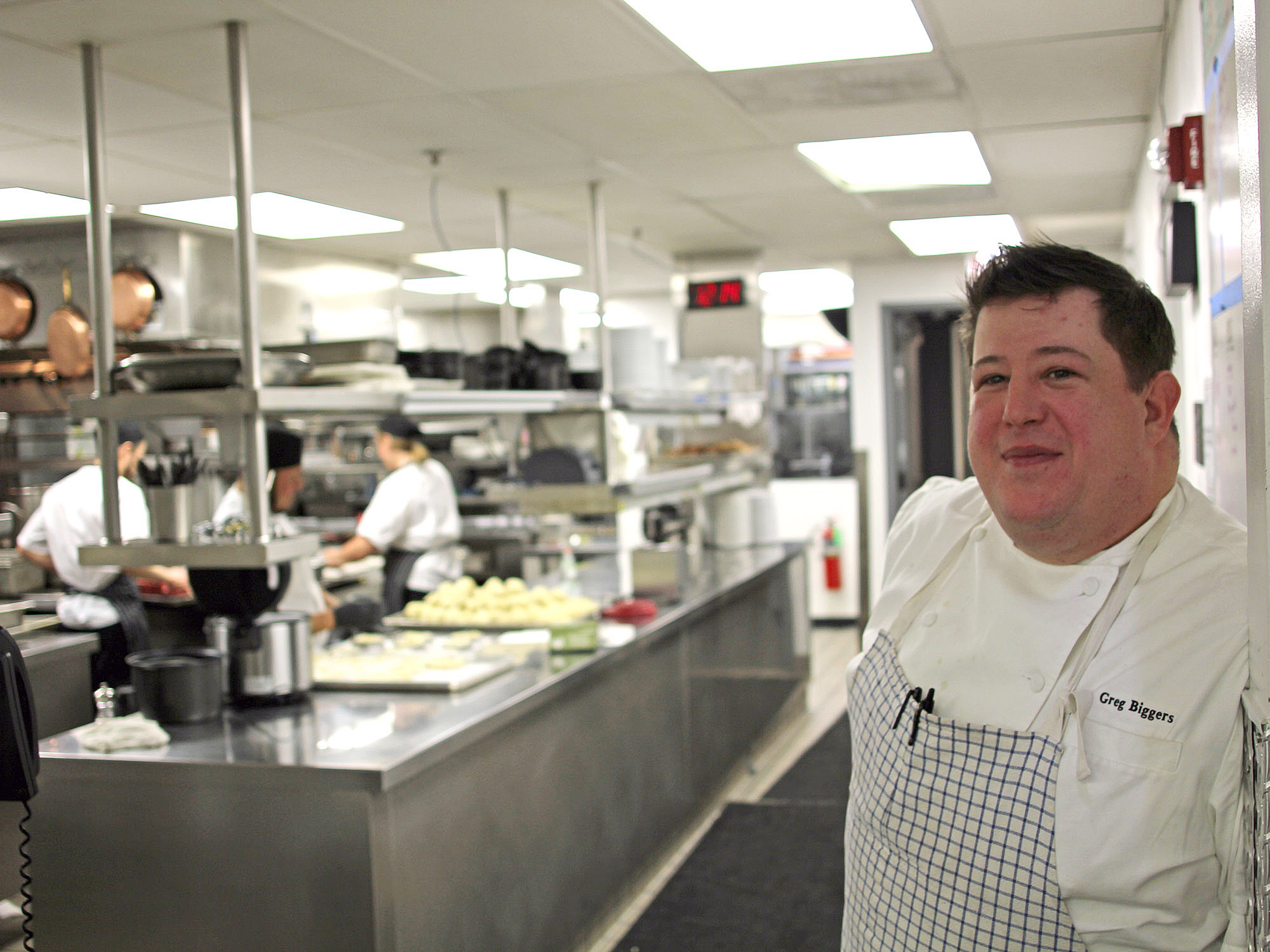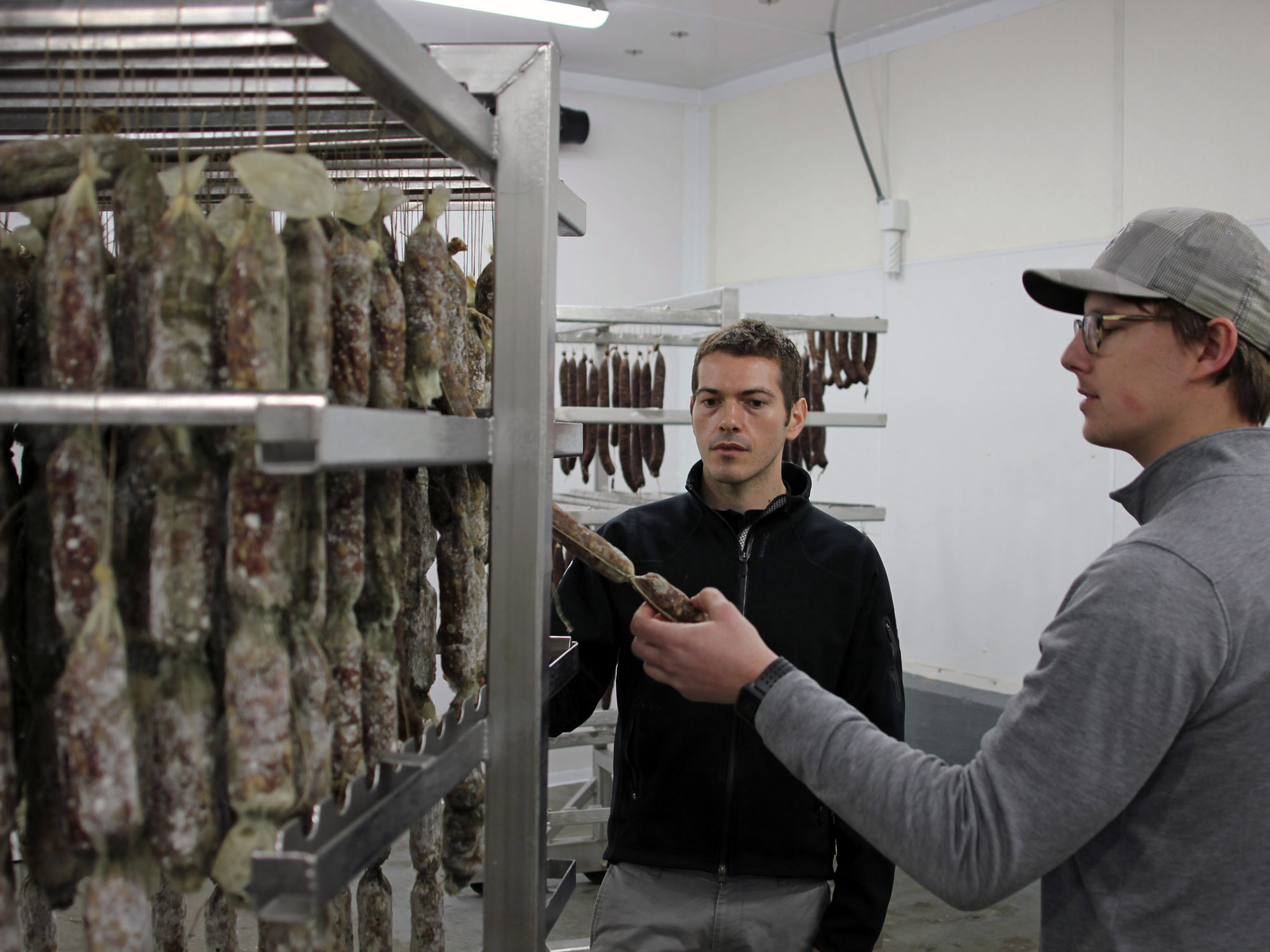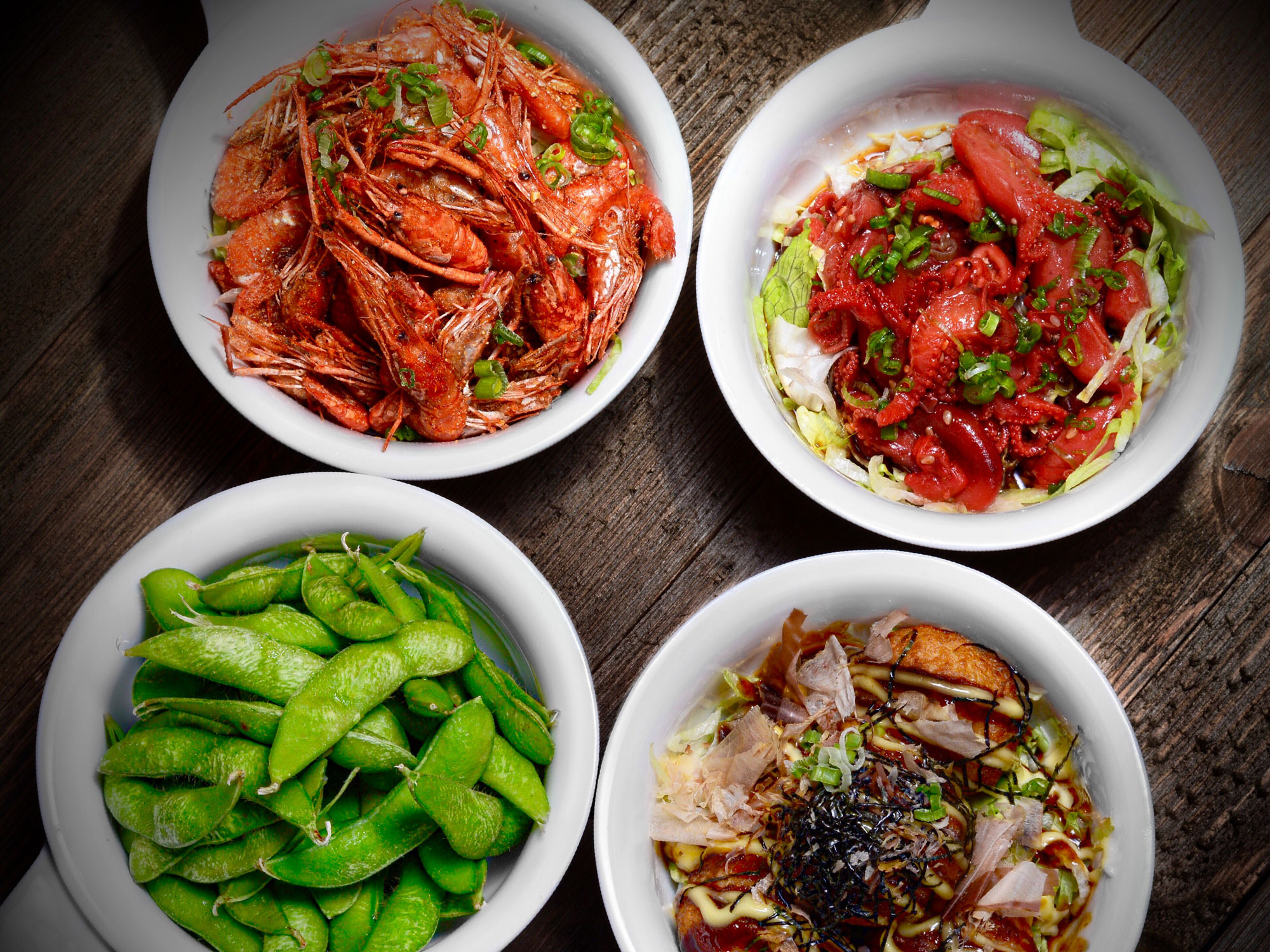WHO IS CHICAGO’S CHINATOWN FOR, REALLY? It’s a question worth pondering any time non-Chinese visit there. Chinatown is a real Chinese neighborhood, with shops and some restaurants which can be forbiddingly opaque to outsiders—but traditionally it’s also been a tourist attraction, selling an idea of Chinese-American food made up of egg rolls and shrimp toast, Mai Tais and World of Susie Wong decor, to draw outside money into the community. And while white Chicagoans who went to Chinatown “to get the authentic stuff” weren’t entirely wrong about that, they were also getting a mirror shown back in their faces, in the form of Chinese food tailored to their expectations.
With China growing wealthier and more globalized, though, things have begun to change. Chinese who come to Chicago are as likely to do so for an American university as they are to work in the back of a Chinese restaurant. They’ve also had experience of internationalized cuisine as a whole—and they use the internet to share their finds as soon as they pop up. The result is a new class of restaurants aimed at Chinese first, food that represents the flavors and the level of sophistication and trendiness they expect when dining out… hip businesses with flashy decor and electronics serving up tastes straight off the streets of Beijing or Chengdu, reflecting trends in Asia from hot pot to Thai rolled ice cream to Northern Chinese spicy lamb skewers and Cajun seafood boils.
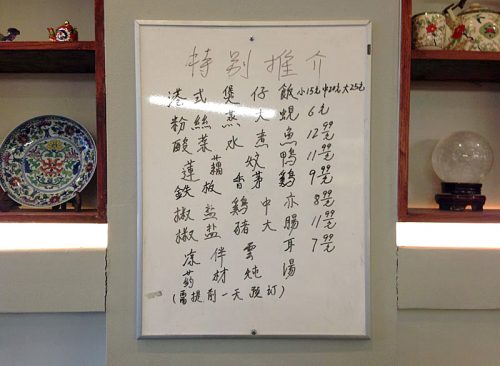
Try ordering off the specials board
So this is a Fooditor Guide to this new, revitalized Chinatown, focusing not on old favorites but on businesses that have opened within the last couple of years. (I left out the Richland Center food court, because an updated version of that Fooditor Guide is in the works.) Places I find especially strong get a star before their names, but really, any place listed here is interesting enough to check out (and I only tried a few places that weren’t worth at least mentioning here).
I wanted a take on as many restaurants as possible, so most of these reports are based on one or two attempts to suss out what the strong points are, often with the help of, yes, Yelp reviews. No, I wouldn’t do that for most cuisines, but you often find well-informed Chinese posting at Yelp, giving excellent advice on what regional specialties a place is good at. Even better would be the Chinese-language social media sites that cover the scene, but that’s beyond my abilities—though you can get some guidance from the Asian food delivery site Chowbus, which displays popular individual dishes by user rating at many Chinatown restaurants. So use this guide as your starting point, and if you find out more in your own explorations, let me know.
I. Wentworth and Cermak
What most Chicagoans think of as the traditional Chinatown was founded in the 1920s, ran south along Wentworth and west along Cermak, and is still home to the oldest Chinese businesses in the city. Dowdy for the last couple of decades, it’s suddenly booming with exciting new businesses.
Dongpo Impression
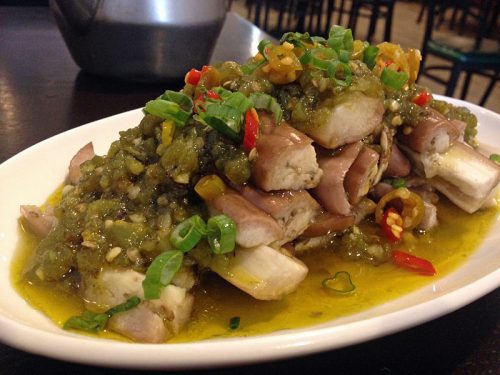
Eggplant with many, many chilis
Where: 228 W. Cermak
Ryan Hu, a nephew of Tony Hu of Lao Sze Chuan fame who has Chengdu Impression on the north side, took over the Yan Ban Cai space to continue serving authentic Sichuan food—if not as devoted to the tingly heat of Sichuan peppercorn as some of the other new places in Chinatown.
Much of the menu matches up with what’s at Chengdu Impression, so I drilled into the appetizer menu at a solo lunch recently. Dan dan noodles were comfy and mild, but perfectly satisfying, while the heat came from the plate of Japanese eggplant with many kinds of chilis piled up on it; this was an eye-opening dish in a couple of ways, but I really liked its blend of veggie freshness and spice. Rural style cured pork sounded promising but—of course—proved to just be a plate of bacon (I took most of it home with plans to use it in an omelet that weekend). Anyway, a pretty good place, but with Chengdu near me, I would seek more novel-to-me Sichuan places in Chinatown. Such as…
* Szechuan JMC
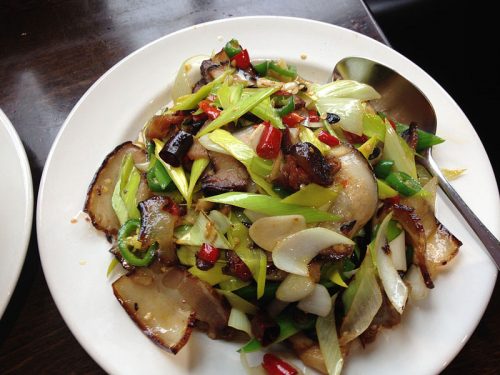
Stir-fried pork belly
Where: 243 W. Cermak
You’d better like the tingly, aluminum foil mouthfeel of Sichuan peppercorn if you try this Sichuan restaurant—because you’re going to get a lot of it. Sometimes too much: the dan dan noodles tasted like they’d been doused in after shave, which was too bad because the chewy, irregularly-cut noodles were really good.
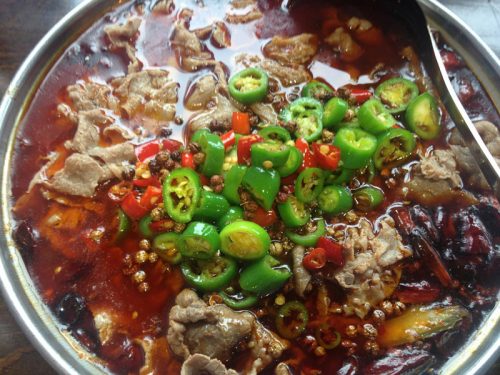
Fatty beef in hot broth
But when they calibrate it right, this is some of the best spicy food in town. The best dish there for me so far is stir-fried pork belly in lots of diagonal-cut shards of leek. The belly, braised in star anise, is beautifully cooked, coming off as being as compulsively scarfable as American bacon, while the dish has a great balance of stir-fry sizzle and peppercorn tang. “Fatty beef” (the beef isn’t fatty, but the broth is) with clear rice noodles came to the table submerged in peppers and looking like a mouthful of hurt, yet surprised with its subtle use of heat and the wok hay of the noodles. There’s a lot of skill in this tiny place’s kitchen.
* Gao’s Kabob Sports Grill
Where: 232 W. 22nd Pl.
One of the hot trends in Chinatowns everywhere is Northern Chinese skewers, or chuanr, grilled meats (especially lamb) in a cumin-heavy spice blend. (Mike Sula wrote more about their history here, and see this LTHForum post as well.) They turn up all over at the moment as appetizers at hot pot restaurants and elsewhere, but there are two spots dedicated primarily to them, Gao’s and Friend BBQ.
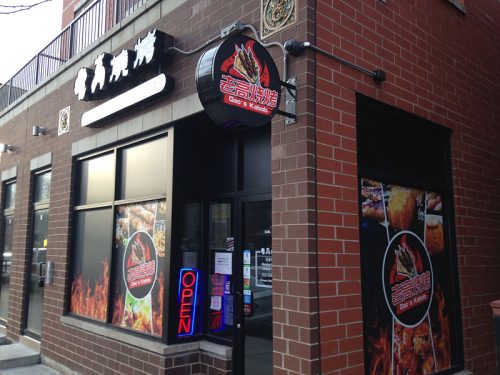
Gao’s is located obscurely up 22nd Place off the main Wentworth strip, but that hasn’t stopped it being full most nights, and it would be my first choice to sample this style of dining, doing an expert job grilling lamb, beef, squid and other meats. By chance, though, the people next to us had ordered an entire grilled Japanese eggplant and it smelled good even a few feet away—so we ordered it too, and it was outstanding, the inside doused with a spicy-sweet sauce very similar to that on the bell dumplings at A Place by Damao.
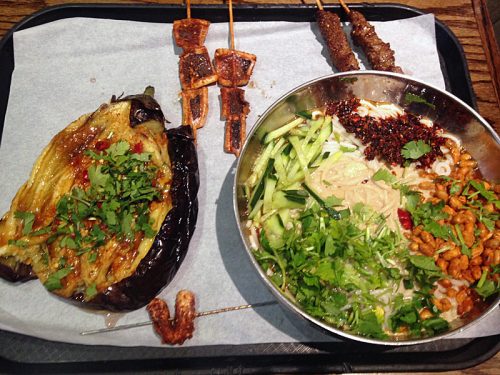
Grilled eggplant, squid and lamb skewers, and Northern dan dan noodles
Gao was the clear winner for skewers, though not so much for larger meats—we tried “chicken bone,” grilled chicken skeleton with some bits of meat clinging to it, and grilled pig’s foot, but they came in second to Friend BBQ and A Place by Damao, respectively.
Curious about what separates “Northern dan dan noodles” from others, we also ordered that and got a huge bowl of noodles, peanut sauce, Sichuan peppercorn and some fresh veggies, served kind of cold. It would have been a great dish—reminding me a little of the veggie-rich bibimbop at En Hakkore—except that the noodles didn’t measure up, coming off like slippery, overcooked American spaghetti. Maybe that’s the Northern style, but I dreamed of a combination of Szechuan JMC’s chewy, square-cut noodles and these toppings.
Little Lamb Hot Pot
Where: 2201 S. Wentworth
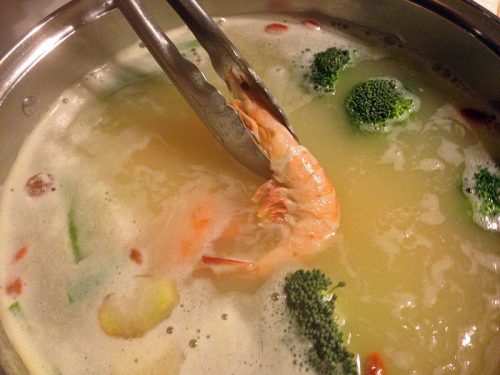
Slowly I begin to understand hot pot, the Chinese (allegedly Mongolian) form of social eating in which you get broth boiling at the table and a host of things to dunk in it till they’re cooked. My first experiences were bland and baffling, literally just boiled meat, but over time I’ve kind of worked out how to have a decent meal at it. More than anything, it’s having a flavorful broth to begin with that makes this work or not, and the Mongolian Herbal broth here was a quality chicken broth bubbling with ginger, goji berries and other things. It made up for a generally disorganized atmosphere in the restaurant, if somehow always saved from sinking into complete chaos by the hustling staff.
I found beef picked up the broth flavor best, followed by pork and lamb; seafood less so, tofu not at all. You probably should have some veggies, but nothing I had, from broccoli florets to mountain yam trailing slime like okra, really gained anything from the broth. So order some meats (cook them just till they turn from red to gray, then eat, or at least take them out to cool a little), eat some veggies just for their own sake, then add the excellent fresh noodles at the end and eat them from the broth. One more note: the all you can eat option ($21.95) is almost certainly a better deal than ordering off the check-off sheet individually, since it is virtually impossible not to over-order, and to rack up a bigger bill than you were expecting, even when the veggies you picked were only a couple of bucks each.
* Wentworth Seafood House
Where: 2229 S. Wentworth
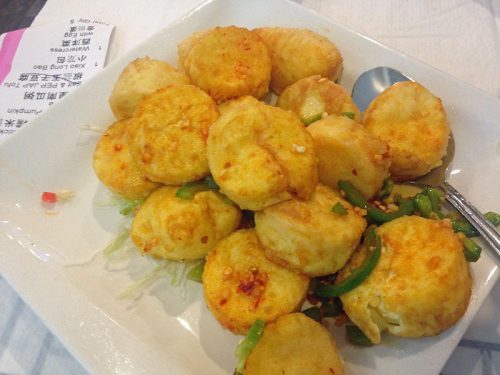
Salt and pepper tofu
With so many new restaurants in Chinatown serving Sichuanese flavors, it’s kind of refreshing to find a new Cantonese restaurant. Wentworth Seafood House, which sounds like it could have been there forever but is only about a year old, offers a dim sum menu and lunch specials through the afternoon, and a Cantonese menu stressing seafood at night. Salt and pepper tofu had a creamy custard-like inside under a crisp fried shell; my first bite was kind of, huh, that’s pretty basic, what it says it is, and by my third bite I was in love. Yelp reviewers strongly recommended seafood pumpkin congee; I usually find congee bland but this was a chickeny broth with bits of seafood in it, and quite comforting (especially with bits of cruller to dip in it).
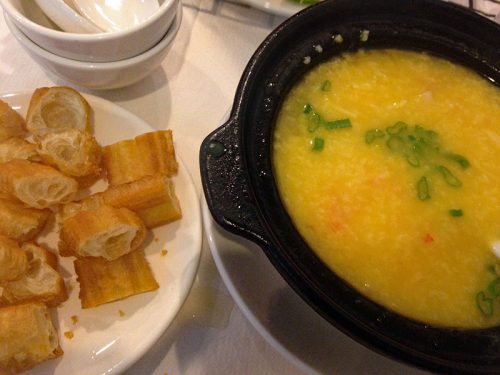
Seafood pumpkin congee
We dabbled around the menu, trying to taste from as many categories as we could. Xiao long bao were routine, if not frozen from a bag at least passing for same, but fried rice with dried shrimp and bits of Chinese sausage was completely scarfable, and stir-fried watercress in a seafood broth with bits of preserved egg smelled like the fish section at an Asian market. I mean that in the best possible way.
* Daguan Noodle
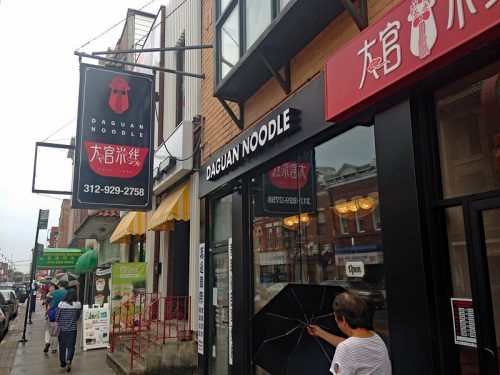
Where: 2230 S. Wentworth
Daguan Noodle is one of only two places in Chinatown to have Michelin Bib Gourmand recognition (the other is MingHin), and if it seems curious why they singled out this one spot above others, you can see why when you order the house specialty, chicken soup—specifically, a style called guoqiao mixian (mixian is the style of fermented rice noodle, and the name means “crossing the bridge noodles”). Steaming broth is served with a tray of meat, veggies, mushrooms, etc., plus the noodles, all of which is dumped into your bowl before you even have a chance to look at it and know what you’re getting.
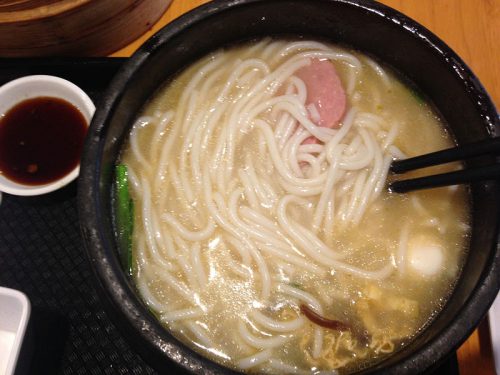
The broth is very good—best chicken soup south of Manny’s, maybe!—and the noodles and meats are very high quality, so for its type, it’s top level. It fits Michelin’s criteria of a high quality, hard to screw up experience that delivers exactly what you’re expecting. My idea of how to eat in Chinatown favors discovery over predictability, but if what you want is a bowl of chicken soup, this is as good as any in town.
* Slurp Slurp Noodles

Where: 2247 S. Wentworth
Until recently, with a couple of openings in the Richland food court, Slurp Slurp had been the only place presently doing hand-pulled and shaved noodles in Chinatown. The hand-pulled are like fresh pasta, and plenty good, but I really love the thickness and the raggedy texture of the shaved noodles (see this piece on another shaved noodle in town)… assuming they have something good to soak up.
At Slurp Slurp, you basically have two choices for that—soup or stir fried noodles (chow)—and then you have different meats which can be added to them (brisket, pork belly, etc.) The soup, rich with five spice flavor (my son said “It smells like Christmas”), is the best way to go; compared to that the stir fry noodles seem a bit bland, though you have various things on the table to doctor them with, and I liked mine just fine once they had some vinegar and chili oil on them. Beyond the noodle dishes there are only a couple of choices, but the steamed potstickers with pork and chive, which I feared might come out of a bag frozen, proved to be housemade and pretty terrific, too.
Yummy Yummy Noodles
Where: 2334 S. Wentworth [entrance on 23rd Place]
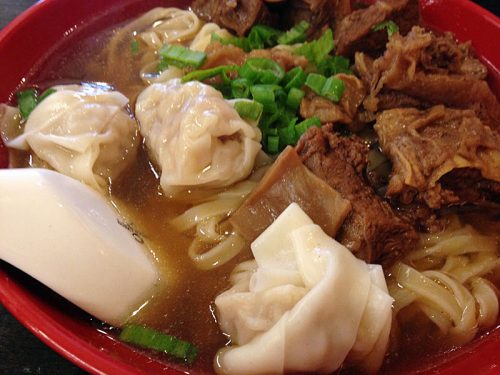
Beef brisket noodle soup with egg noodles and pork wontons
Yummy Yummy Noodles got its start in the Richland Center food court before finding a bigger and more attractive space just off Wentworth; it still seems a little undiscovered, so it might be a place to find a seat when hotter nearby spots are giving half hour waits. The thing to have has always been the beef brisket noodle soup, a comfy broth with hunks of five spice-scented beef; it’s a steal at $5, so you might as well spend $2 more and get a few pork wontons, which have complexity of flavor the simple soup lacks otherwise. I ordered pork with XO sauce to see what stir-fry dishes would be like now that they offer a much longer menu, and it was fine, good wok hay and lots of green vegetables. It’s a pleasant place, if not a destination worth traveling for from across town in itself.
* Happy Lamb Hot Pot
Where: 2342 S. Wentworth
This hot pot spot opened as Little Sheep Mongolian Hot Pot, part of a Chinese chain purchased in 2011 by Yum Brands (Taco Bell, KFC). But as of a recent visit, the signage has been changed to Happy Lamb Hot Pot, so my guess is the local franchisee bailed on being part of a chain which nobody recognizes the name of anyway.
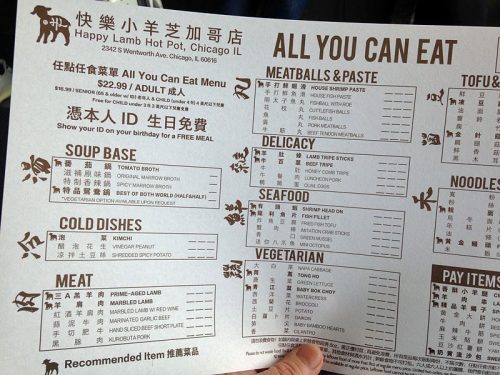
Nevertheless, time spent as part of a corporate chain seems to have paid off in this place generally having its act together better than others I’ve been to, making it an easy first choice for hot pot novices, who can start with with the recommended items on the check-off menu.

Streaky bits of lamb belly and beef shortrib (maybe; somewhere in the vicinity, anyway) were served well by the broth, which is accompanied by little dishes of other ways to doctor it up like chopped garlic or peanut sauce. I also enjoyed the shrimp paste, more like shrimp batter, which you scooped bits of and dropped in the broth to make dumplings. All in all, the most successful hot pot experience I’ve had, at $22.99 worth the $1 premium over the competitor mentioned above.
Friend BBQ
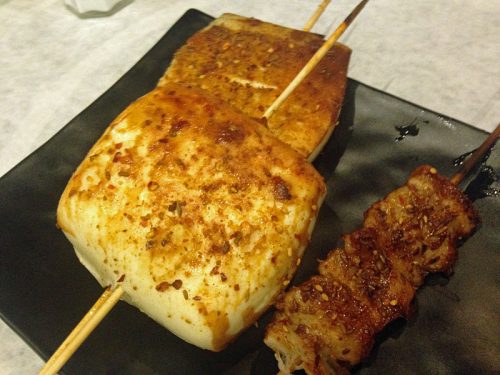
Grilled bao and lamb skewers
Where: 2358 S. Wentworth
Friend BBQ seems to be the name everyone has settled on for this Northern Chinese grilled skewer business, which is either related to or copying a New York spot called Friendship BBQ, but at least when I went, that name didn’t appear anywhere, so find it by the address. Anyway, it’s another Northern Chinese skewer place, serving various meats (and the hunk of bread seen above) seasoned with the same spicy seasoning and grilled. Lamb was good, grilled squid was very good… and then there were a few surprises, like “aorta,” which I took to be a pig aorta, though after I posted the picture someone suggested “trachea” was a more likely description.
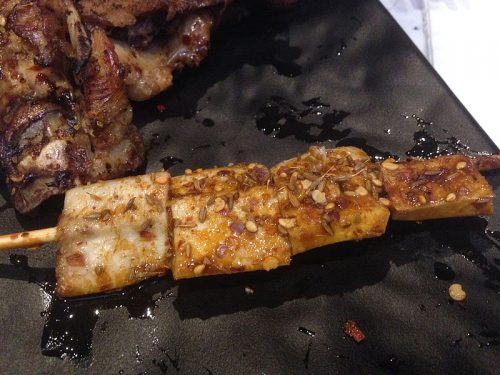
Aorta skewer
That was a novelty unlikely to be repeated, but another item we ordered just because of the name, “chicken skeleton,” proved to be one of the stars—hacked up pieces of a carcass after it was mostly cleaned of meat, grilled. You had to work with your teeth to get those last bits of meat off the carcass, but it had great grill flavor and was surprisingly satisfying. There are some veggie side dishes too (we had a very good plate of stir-fried pea shoots), but by and large everyone in the room is eating meats off sticks, and dropping them in buckets; they also offer a version of hot pot in which you dip the skewers in the broth bubbling at your table.
II. Chinatown Square Mall
The Chinatown Square mall along Archer has long been where to go for many of Chinatown’s newest and most popular restaurants, including the Tony Hu empire and the Richland Center food court. It’s been eclipsed of late by new openings on Wentworth, but it still packs a lot of interest into a modest area, with a couple of new outposts of international chains.
* MCCB
Where: 2138 S. Archer (Chinatown Square mall)
For this one, I’ll just quote me, from the newest Fooditor 99:
Chicago’s Chinatown is changing in fascinating (if often baffling to an outsider) ways… MCCB, which stands for Modern Chinese Cook Book, sums up both the fascination and the bafflement for me. Some of it is recognizable enough for anyone who’s been eating at Lao Sze Chuan—dan dan noodles, Chengdu spicy dumplings, mapo tofu, dry chili chicken; even the whole fish or charcoal grill ribeye steak is basically recognizable as protein buried in a ma la-heavy soup base in an ornate rectangular box.
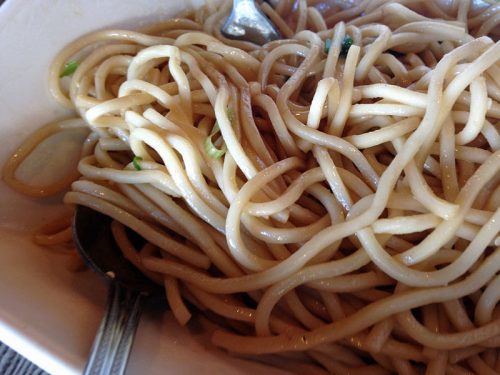
Pig Oil Green Onion Noodles
But then there are dishes out of some food culture you’ve never seen before—the cold noodles coated in smoky wok hay-tasting lard (Pig Oil Green Onion Noodles), the fresh okra served on ice like a shrimp cocktail (a slimy one). And that’s just scratching the menu; who know what else is in this modern cookbook, waiting to blow your mind.
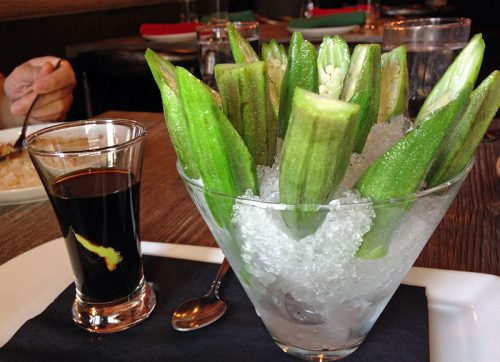
Fresh okra
Bonchon
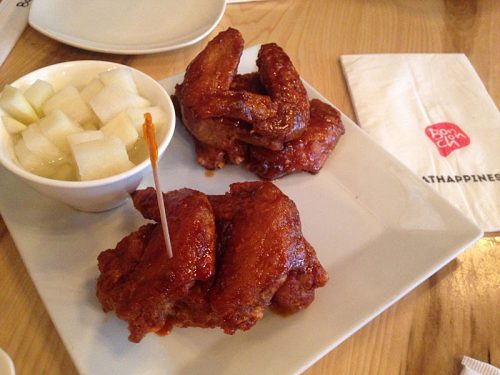
Where: 2163 S. China Place #1f (Chinatown Square mall)
The mirrored wall at this Korean fried chicken chain’s Chinatown shop (there’s also one in Wicker Park) cites dozens of placenames… apparently representing just the American outposts of this popular global chain. (It was one of the first things we saw in Bangkok, too.) The chicken is fried twice for a super-crispy exterior, and then gets either a sweet soy-garlic glaze or a spicy one—which I should point out would rank near the top on a Nashville Hot chicken scale, capable of inflicting serious pain. There are other things like dumplings and pork bao and even some full dishes, but I didn’t see anyone not ordering chicken, and if the food has a slightly factory-produced feel inevitable in this big a chain, it’s about as good as chain fried chicken gets.
Tous Les Jours
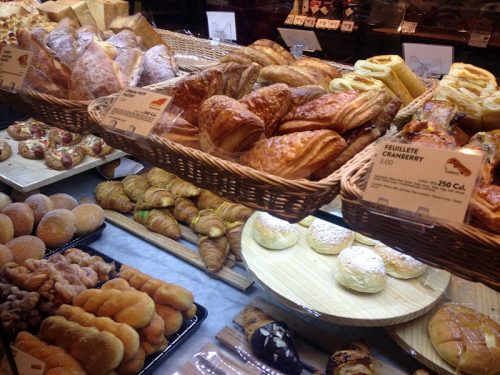
Where: 2144 S. Archer Unit A (Chinatown Square mall)
Another international chain (there are other Chicagoland outposts in Schaumburg, Glenview, Vernon Hills and Naperville), this Korean take on French pastry-making reminded me of the deliriously colorful pastries I saw in Tokyo’s food halls, acres of brightly kawaii fruit colors and white frosting making the whole food hall look like a place where My Little Pony would frolic. There are so many choices, changing constantly, that it’s not hard to fill up a tray with choices ranging from cream cheese-and-fruit stuffed croissants to rice flour doughnuts to savory pastries with hot dogs or brie cheese.
Overall, I’d rank them as pretty good, not up to Princi as local chain arrivals go, but certainly pleasant enough, and delighting with all their unexpected variety; while the shop seems a bit of an escape from the general franticness of Chinatown Square dining. The time I took these photos, there was a group of schoolgirls singing Happy Birthday to one of their party. It was like living in an animé.
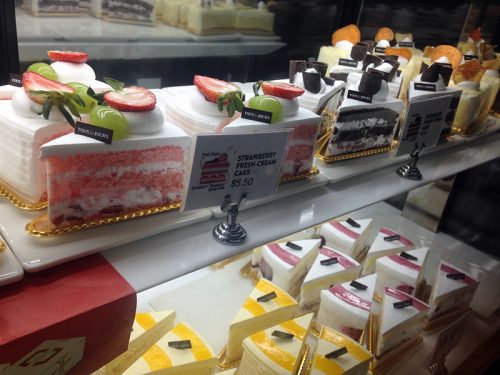
Bingo Tea

Where: 2150A S. Archer (Chinatown Square mall)
Bingo Tea is a small snack shop offering teas and a few baked goods (similar to Tous Les Jours above), that has since spun off a more elaborate restaurant on Argyle serving Malaysian dishes as well as tea drinks. Some of the teas come with a “milk cap,” which is their attempt at finding a better term than the one that Chinatown watchers have already heard for the layer of salty cream on the top of these teas—”cheese tea.” Either way, it’s an unusual sensation that may quickly grow on you, the lightly salted foam coming off a little like yogurt as it mixes with the tea (fruity or tannic) below. (My technique is to take a little sip of the cream, then a thick slurp of the tea.) Cheese tea—count me a fan!
III. Beyond Chinatown
Long confined to Chinatown’s borders by the Irish and Lithuanians of Bridgeport, Chinese businesses are finally spreading to the surrounding neighborhoods. Two strip malls—one on the other side of the El tracks northeast of the Chinatown Square mall, the other west of Chinatown on Halsted in Bridgeport—are establishing the borders of a new Chinatown with their food.
Meet Fresh and Tsaôcaa
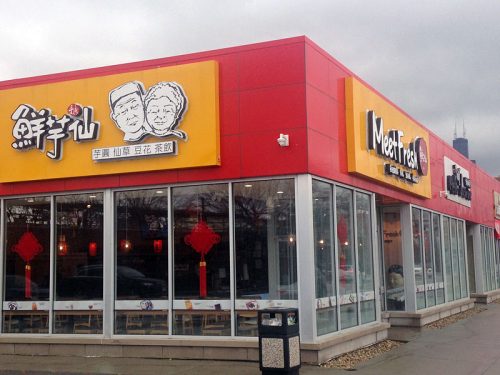
Where: 2026 S. Clark, Unit A&B/Unit G
The small new strip mall on Clark is home to two tea and dessert shops, with a third coming when Hello Jasmine (currently in the Richland Center food court) opens a full restaurant soon.
Meet Fresh is a Taiwanese chain with some locations in California and major cities elsewhere. The focus is on various cold treats in bowls, built around things like cold grass jelly (think a vegetal Jell-O) or Taiwanese shaved ice. Whatever the base is, it’s topped with squiggly gummy treats, from taro balls to mochi gummies to milky gelatins a la panna cotta. On friend of Fooditor Brian Eng’s recommendation, I tried Pudding & Q Mochi Milk Shaved Ice (below), which was full of interesting tastes. It was also big enough for four or six people, and accordingly cost as much as a pizza, so this is the kind of thing you get when you’re a group of teenagers hanging out together—not when you’re a food writer trying to finish an article by yourself.
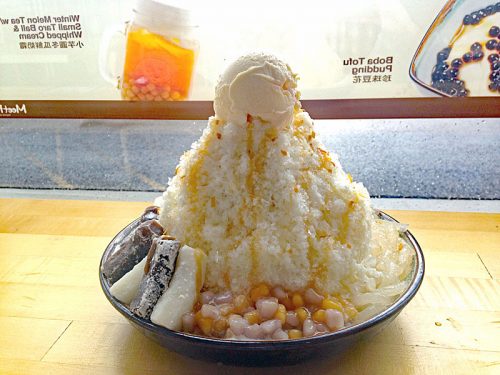
Pudding & Q Mochi Milk Shaved Ice
Tsaôcaa has some shaved ice and jelly desserts, as well as French macarons and even tiramisu, but its main focus is on tea, including cheese tea as mentioned above. I told Brian Eng that I was interested in fruitier teas as opposed to oolong, and he suggested their osmanthus milk tea, called “fragrans” on the menu, which he says is very common in the Chinese community in L.A.’s San Gabriel Valley, but which he had not seen here until Tsaôcaa opened. It was an excellent recommendation, a beautiful floral tea which complimented the milk in a way that stronger green and black teas do not.

* Taipei Cafe
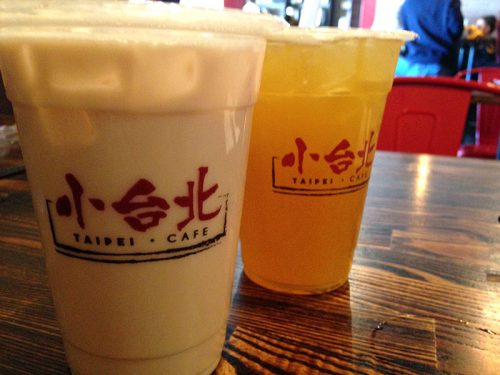
Where: 2609 S. Halsted
Meanwhile, over on Halsted, what’s still the only full Taiwanese restaurant in the city draws a crowd for milk tea and comfort foods like popcorn chicken (the Taiwanese version of fried chicken, which is wonderfully crispy and insanely scarfable; a required order) and braised pork over rice. The milk tea is excellent; I find the comfort foods, well, comforting if sometimes a bit on the bland side. Potstickers looked cool in the lacey batter that you break them out of, like removing the parts of a model airplane from the plastic, but didn’t quite live up to the presentation.
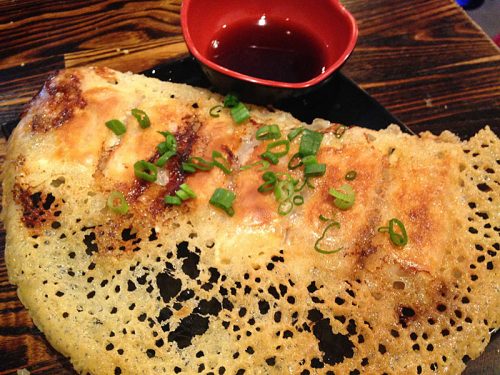
The beef and the noodles in their beef noodle soup were both excellent, but the broth improved a lot once you gave it some drips of the tableside hot chili oil. Braised pork belly on rice is simplicity itself, but there’s so much five-spice flavor in the pork that it triumphs not only over the rice but even the large portion of steamed broccoli. And pork belly is the star again of gua bao, buns with pork, peanuts and greens. So a variable menu where you want to seek out their strengths, but the best things were very pleasing—starting with a glass of milk tea.
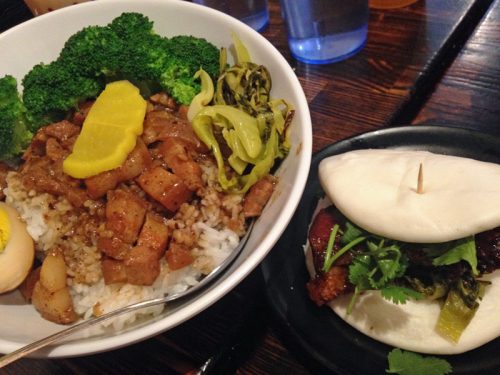
Braised pork over rice and pork gua bao
* A Place By Damao

Handmade bell dumplings
Where: 2621 S. Halsted
The subject of this Fooditor piece, A Place by Damao has jumped to foodie fame for a clear, authentic concept: Chengdu street food, usually things as simple as noodles or dumplings or fried duck necks, and volcanically spicy. But there’s variation within the heat—sometimes a little note of sweetness, as in the signature bell dumplings, other times the metallic tang of Sichuan peppercorn. Either way, everything is pleasingly handmade (the tiny restaurant, soon to expand, has a prep kitchen across the street).
Min’s Noodle House
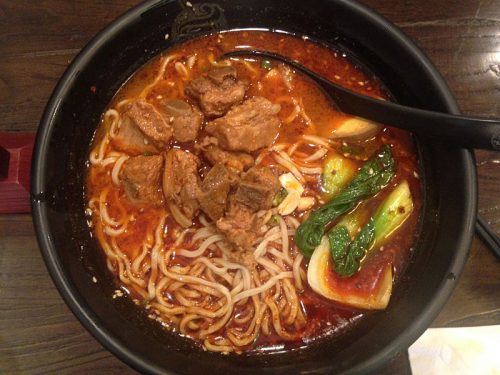
Where: 3235 S. Halsted
This Szechuan restaurant’s specialty is Chongking noodle soup, that is, crinkly noodles in a volcanic bowl of spice and oily broth, served with half a hardboiled egg and a braised meat cut of your choice (beef or pork, mostly). It’s reasonably satisfying on a wintry day, but I wanted the broth to have more dimension to it, to be a worthy competitor for ramen or pho, and it wasn’t, really. It’s mainly just hot and oily.

What saved my lunch here was the pork bao I ordered on the side. The size of a cinnamon roll, it was full of minced Asian pork goodness, and I’d have had another if I hadn’t been looking at a half-eaten bowl of soup. It’s good to know that it exists, if I’m ever in need of a lifesaving snack in Bridgeport—and I saw another tempting one as I was leaving; it looked like a Chinese family was chowing down on crullers and soy milk, a popular breakfast dish I’ve only seen at the food court in Westmont where Hanbun used to be.
After my so-so visit, I saw Brian Eng on Twitter talking about liking this place, so I asked him what stands out for him. He praised the bao as the best in town (hurray, I got one right) as well as diced chicken noodles with serrano chilis, hot and sour soup with sweet potato noodles, and dan dan noodles. So now, even after trying this many restaurants, I have something new to try when I go back to Chinatown… and I hope you do, too.
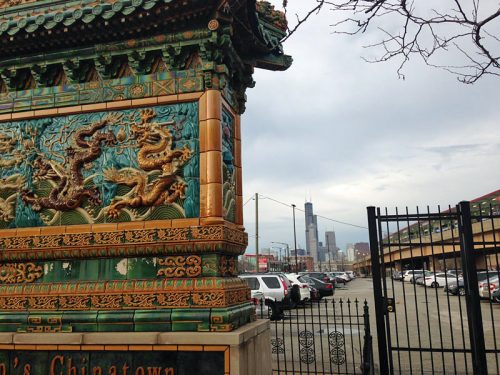
Michael Gebert is the big gua bao as editor of Fooditor.
Special thanks to Brian Eng for many insights (only I am to blame for my good or bad opinions, though), and to fellow diners including Liam Gebert, Susan Snyder, John Lenart, Keng Sisavath, and John Kessler.
Latest
Join the Discussion
After you comment, click Post. If you're not already logged in you will be asked to log in or register with Disqus.





